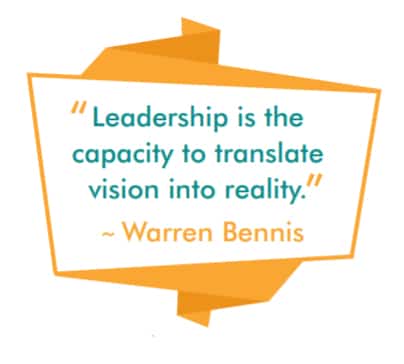Our topic today is leadership vision and how to translate it to mission, goals, targets, and measures.

Transformational and Joyful Leadership define vision as its core components while many other theories acknowledge the importance of a vision. Charismatic leaders may choose to use their charisma to lead followers towards a more positive vision for the future (Martin Luther King or Mahatma Gandhi). Articulation of a vision is affected by limbic system activity (Morse,2006) and can be traced on a neurological level. Thus, having a vision is influential socially, psychologically and biologically. Providing inspiration starts with a clear vision for a better future. A joyful leader in an organization will, as a rule, develop the whole system based on an agreed vision.

Leading through vision together with setting out values is emotionally appealing and motivating but it is not enough in a business environment. Thus, translating the vision (the dream or picture of your future) into the mission (what we must do to make it real) and then setting precise goals with appropriate measures to monitor the execution is needed, if the organization is to be effective and efficient. In the first picture, you can see the whole circular system as presented by The Laboratory of Social Psychology. It is being designed from top to the bottom and measures at the bottom tell us how much of a vision has been achieved. The system can be modified according to the results achieved and put to work again.

A wise leader will involve the whole team in developing the vision from the start. People are motivated by a clear understanding of what they need to do to accomplish the vision. Each person will learn how to contribute meaningfully toward team goals ensuring personal and team growth in a win-win situation. It is not a surprise that 90% of the fastest growing US companies are run by their founders, with vision and skills to change it during organizational transitions. Circling through the system presented in the kaizen manner during change ensures the growth and vitality of the organization.

Perhaps the best-known system operating in thousands of companies is Balanced Scorecard which further develops the measurement system needed. Balanced Scorecard (BSC) was originally developed by Dr. Robert Kaplan of Harvard University and Dr. David Norton (1992) as a framework for measuring organizational performance using a more BALANCED set of performance measures. They revolutionized conventional thinking about performance metrics based on the idea “What you measure is what you get.” Its objective is to translate an organization’s mission and vision into operational actions as a model of strategic planning. Thanks to them now leaders have the tool to use in leadership implementation to the real life.

All goals developed from vision and mission represent strategy which is further grouped into 4 sets of objectives, measures, targets, and initiatives needed, as shown in the second picture. The 4 groups are Financial Perspective, Internal Busines Processes, Learning and Growth, and Customer Perspective. When objectives, measures, and targets are set the leader makes sure the initiatives the team has to undertake are implemented. The results inform the leader and the team how much of the vision has been achieved and point out the areas of improvement. Thank you and hope you have enjoyed the basic information about leadership and vision. You can practice leading, the vision setting, and implementing the system in our joyful leadership workshop.

Join our free Joyful Leadership online course today! Start here.
SOURCES:
- Petar Turcinovic, Joyful Leadership Manual
- Turčinović, P. (2000). Visionary leadership in action. Unpublished manuscript, Laboratory of Social Psychology, Croatia.
- Kaplan, R.S., Norton, D.P. (1992). The Balanced Scorecard – measures that drive performance. Harvard Business Review, 69(1), 71- 79.
- Kaplan, R. S., Norton D. P. (1996). The Balanced Scorecard: Translating strategy into action. Boston, MA, US: Harvard Business School Press.
